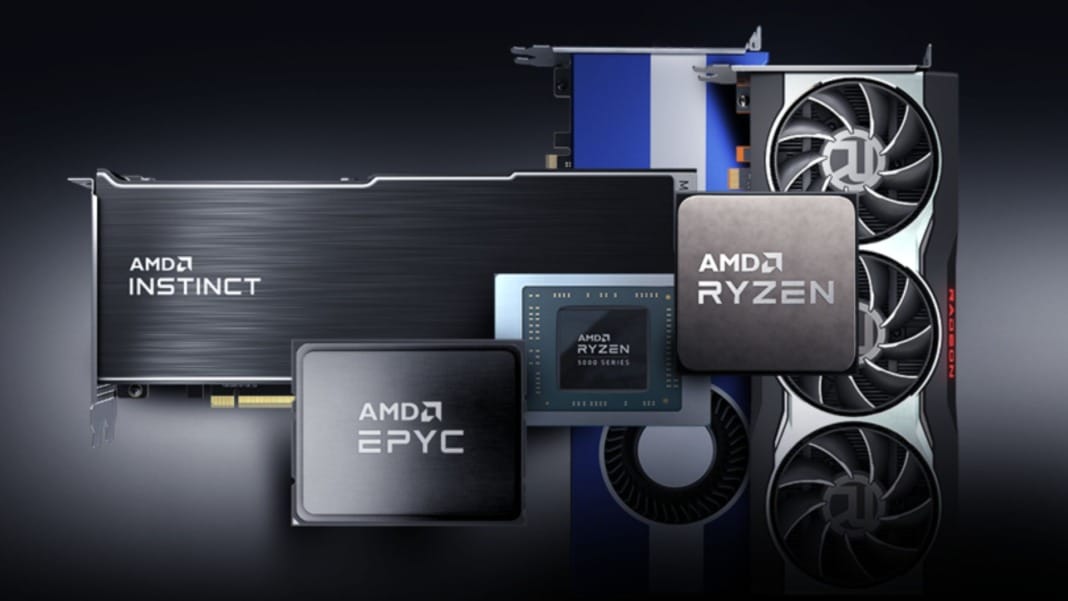AMD is ready to make a comeback in the world of high-performance laptop GPUs, a segment that Nvidia has largely dominated. A fresh leak from Golden Pig Upgrade Pack on Bilibili hints that AMD is developing four new laptop GPUs as part of its RDNA 4 lineup, potentially positioning one of its top offerings as a rival to Nvidia’s upcoming RTX 5090. While it’s too early to say whether AMD’s new flagship will match Nvidia’s performance, the specs indicate that AMD is ready to compete.
According to the leaked slide, AMD’s RDNA 4 lineup will introduce four distinct laptop GPUs with varying power and memory configurations to cater to different performance needs. Although the exact model names remain unknown, the slide provides some insight into the specifications of these graphics cards, such as power consumption, memory size, and memory bus width.
The flagship GPU in AMD’s new lineup is known by its chip name, R25M-E6, where “M” signifies its laptop-focused design. This GPU will reportedly offer a power consumption range of 80 to 175 watts and be equipped with 16GB of VRAM on a 256-bit memory bus. This configuration closely matches Nvidia’s upcoming RTX 5090, which is also expected to feature 16GB of memory in its laptop form. However, other recent leaks suggest Nvidia’s RTX 5090 might see an upgrade to 24GB of VRAM thanks to newer memory modules. If true, Nvidia’s flagship would likely outperform AMD’s top laptop GPU in pure memory capacity.
Additional options for gamers and creators
AMD’s following two GPUs, the R25M-P6 and R25M-P4, offer configurations designed for mid-range performance, making them suitable for mainstream gaming laptops and creative workstations. The R25M-P6 has a power draw similar to the flagship at 80 to 175 watts but scales down to 12GB of VRAM on a 192-bit memory bus. Meanwhile, the lower-end R25M-P4 sports 8GB of VRAM on a 128-bit bus, with a total board power (TBP) between 75 and 150 watts. AMD’s final entry, another R25M-P4 variant, has the same 8GB VRAM but operates within a lower TBP range of 50 to 130 watts, targeting power-efficient designs suitable for lightweight, portable laptops.
Despite these promising specifications, it’s essential to note that AMD’s RDNA 4 architecture may still be months from its official release. According to AMD CEO Lisa Su, RDNA 4 is scheduled for early 2025, though this timeline might shift, and the company could delay the laptop GPU lineup. The leaked presentation slide points to a potential 2025 or even 2026 release, meaning these GPUs might not hit the market for some time.
AMD’s integrated GPUs may preview its RDNA 4 branding
Another exciting development comes from AMD’s plans for the upcoming Ryzen AI 300 Max APUs. These processors will feature RDNA 3.5-based graphics capabilities, showcasing the Radeon 8000 branding for integrated GPUs. According to Wccftech, these iGPUs will range from 16 to 40 compute units (CUs), potentially offering performance levels that could rival some discrete laptop GPUs.
The Ryzen APUs’ integrated GPUs are expected to adopt model names like Radeon 8060S and 8050S, a naming style reminiscent of AMD’s discrete RX 8000 series. However, these integrated GPUs are based on RDNA 3.5, not RDNA 4, which might cause some confusion among consumers.
As AMD’s RDNA 4 launch approaches, the company reportedly considers refreshing its RDNA 3-based Navi 33 GPU for laptops. This move suggests that AMD is keen to bolster its laptop graphics lineup, which has previously been challenging to find in consumer laptops. If this new RDNA 4 and refreshed RDNA 3 GPUs make their way into mainstream devices, AMD could finally establish a more visible presence in gaming laptops.
AMD’s strategy signals renewed competition in laptop GPUs
While these GPUs’ final performance and availability remain unknown, AMD’s latest developments indicate a serious intent to challenge Nvidia in the laptop market. By offering a flagship with memory and power levels similar to the RTX 5090, AMD could present an appealing alternative for laptop gamers and creators. However, as Nvidia’s RTX 5090 is still likely to lead in high-end performance, AMD will need more than competitive specs to make a significant impact.
With a lineup of new discrete laptop GPUs and high-performance integrated options, AMD’s RDNA 4 could be a turning point for its presence in gaming and professional laptops. As we move into 2025, consumers should expect a stronger choice of AMD-powered laptops that may better compete with Nvidia’s dominance.




